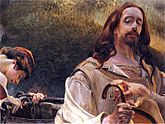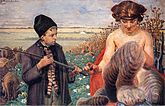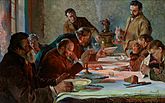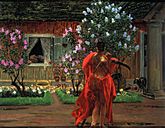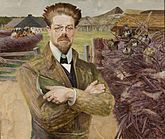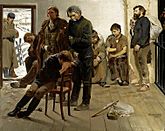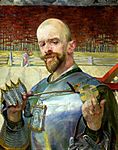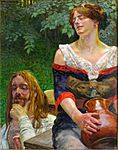Jacek Malczewski facts for kids
Quick facts for kids
Jacek Malczewski
|
|
|---|---|
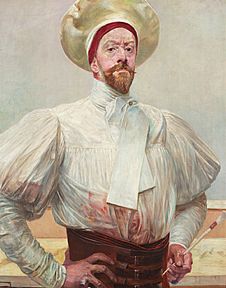
Self-portrait, 1914
|
|
| Born | 15 July 1854 Radom, Congress Poland, Russian Empire
|
| Died | 8 October 1929 (aged 75) |
| Nationality | Polish |
| Known for | Painting |
| Movement | Symbolism |
Jacek Malczewski (born July 15, 1854 – died October 8, 1929) was a famous Polish painter. He is known as the father of Polish Symbolism. This means he used symbols in his art to show ideas and feelings.
Malczewski is one of Poland's most respected painters. He was part of the patriotic Young Poland movement. This movement happened after Poland had been divided by other countries for a hundred years. His art mixed the popular style of his time with Polish history. He also used ideas from Greek and Christian stories, folk tales, and his love for nature. His son, Rafał Malczewski, also became a painter.
Contents
Early Life
Jacek Malczewski was born in Radom, a city in Congress Poland. At that time, Poland was controlled by the Russian Empire. His father, Julian, was a Polish patriot. A patriot is someone who loves and supports their country. Julian taught Jacek about romantic literature. This literature was about the November Uprising, a fight for Polish freedom.
Jacek's family often visited their relatives, the Szymanowskis, in the countryside. His uncle, Feliks Karczewski, also helped raise him. His uncle invited a future writer, Adolf Dygasiński, to teach Jacek at home. This helped Jacek appreciate the beauty of the Polish landscape and its traditional stories.
Becoming an Artist
When he was 17, Malczewski moved to Kraków. In 1872, he started learning art from Polish painter Leon Piccard. He also took classes at the School of Fine Arts. A year later, in 1873, he officially joined the school. He studied with famous teachers like Władysław Łuszczkiewicz and Jan Matejko.
In 1876, Malczewski went to Paris, France. He studied art there for a year at the École des Beaux-Arts. He then continued his studies at the Académie Suisse. He finished his master classes with Jan Matejko in 1879. Matejko's historical paintings, full of patriotic ideas, greatly influenced Malczewski. He was also inspired by the dramatic art of Artur Grottger. Malczewski used his imagination to create new art ideas. This led to the unique Polish style of Symbolism.
What Inspired His Art?
For about 30 years, from 1885 to 1916, Malczewski often visited cities like Paris, Munich, and Vienna. He also traveled to Italy, Greece, and Turkey. He even joined a trip to explore old ruins with his friend Karol Lanckoroński.
Malczewski found ideas from many different places. These included faraway lands and stories from the Bible. He then used these ideas in his paintings, mixing them with Polish folk tales and traditions. Some of his most famous paintings include Błędne koło (Vicious Circle) and Melancholia. He also painted Thanatos (a series about death) and Bajki (Fables). Many of his paintings show him in fancy costumes. He often added a funny touch to these self-portraits.
From 1897 to 1900 and again from 1912 to 1921, Malczewski taught at the Academy of Fine Arts in Kraków. In 1912, he became the head of the academy. His art has been compared to other famous symbolist painters. These include Gustave Moreau from France and Arnold Böcklin from Switzerland. His paintings won many awards at art shows. He won awards in Berlin in 1891, Munich in 1892, and Paris in 1900.
His Life and Family
Malczewski married Maria Garlewska. They had two children, Julia (born 1888) and Rafał (born 1892). Rafał also became a painter.
Jacek Malczewski lost his eyesight near the end of his life. He passed away in Kraków on October 8, 1929. He was buried at Skałka, a famous burial place in Poland.
Famous Paintings
-
Jacek Malczewski, Hamlet Polski - Portret Aleksandra Wielopolskiego.jpg
Poland's Hamlet, 1903, National Museum in Warsaw
-
Malczewski Jacek Portret kobiety.jpg
Bacchante, ca. 1907, Lviv National Art Gallery
-
Bledne kolo.jpg
Vicious Circle, 1895-1897, National Museum Poznań
-
Siberian Wigilia, 1892, National Museum Kraków
-
Thanatos, ca. 1899, National Museum in Warsaw
-
Portrait of Władysław Reymont, 1905, National Museum in Warsaw
Images for kids
-
Melancholia (1894), National Museum in Poznań
See also
 In Spanish: Jacek Malczewski para niños
In Spanish: Jacek Malczewski para niños
- Sukiennice Museum in Kraków
- National Museum, Kraków
- Culture of Kraków
- City of Radom
- List of Polish painters
- List of Poles


